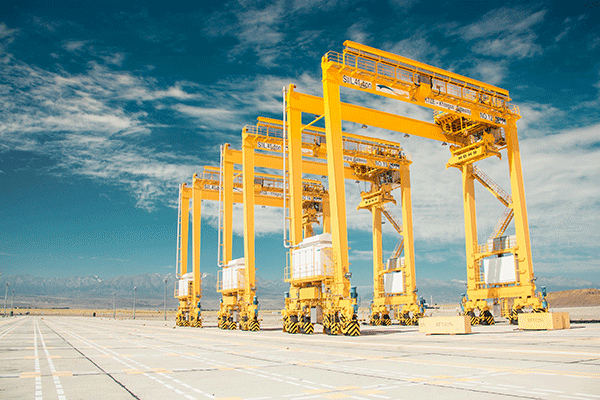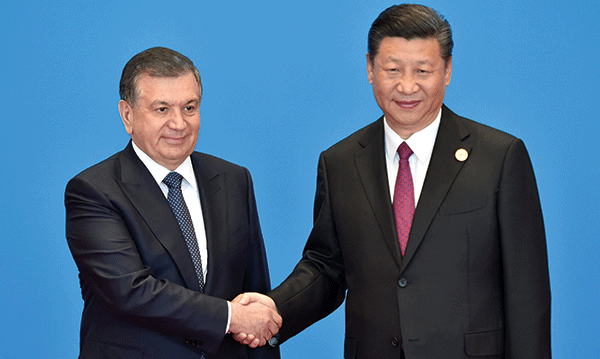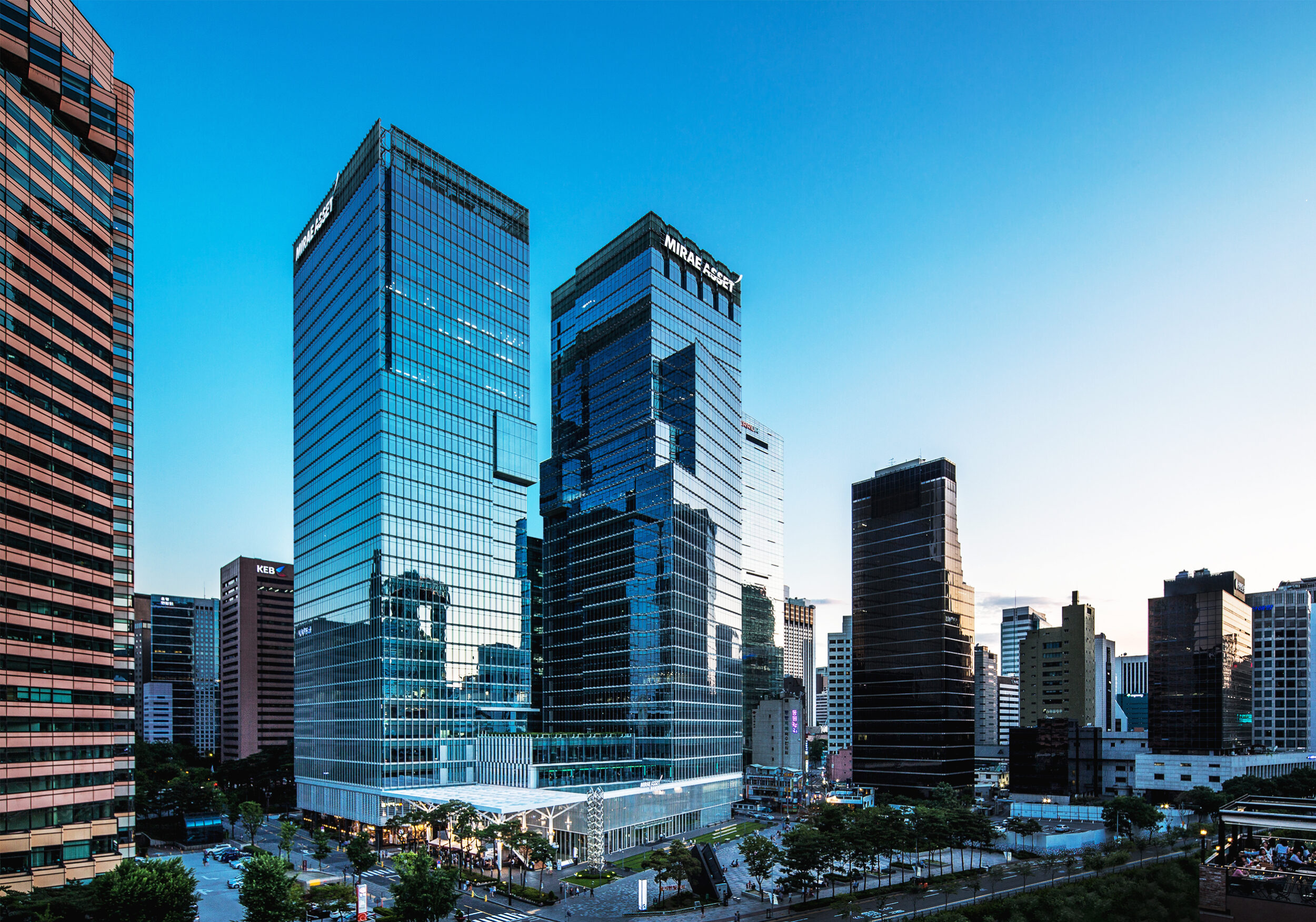 |
 |
|
|
BELT AND ROAD |
|
When Chinese president Xi Jinping first laid out his vision for the Belt and Road Initiative in 2013, he did so in the new capital of Kazakhstan, Astana. Symbolically and geographically, it was an appropriate venue. As a quick look at a map will show, central Asia is clearly a vital link in any trade route between China and Europe, today, as at the time of the original Silk Road.
Astana was also a place where Xi could be sure of a warm welcome for the new concept. BRI dovetailed neatly with proposals previously put forward by Kazakhstan’s long-standing president, Nursultan Nazarbayev, to transform the country into a regional transport hub.
Already under discussion at the time of Xi’s speech, this plan gained momentum in late 2014 following the collapse of the oil price. In a bid to save the heavily oil-dependent Kazakh economy from recession, Nazarbayev promptly announced a $9 billion infrastructure development initiative.
Dubbed Nurly Zhol, or ‘Bright Path’, the programme covered everything from power plants and water systems to schools and social housing. Above all, however, it called for massive spending on transport and logistics infrastructure to facilitate the transit of goods both within and beyond Kazakhstan.
Key projects included the construction of a new railway line from Dostyk on the Chinese border to Aktau on the Caspian Sea, the building of a new Caspian port at Kuryk and the completion of the Kazakh section of the western Europe-west China highway.
The landmark initiative from a Belt and Road perspective, however, is the creation of the Khorgos-Eastern Gates Free Economic Zone (FEZ). Located on the Chinese border, the site of this ambitious project was deserted until five years ago. Today, it is a big transport link between China and Kazakhstan.
In a newly constructed dry port, westbound cargo is transferred from Chinese trains to the wider gauge models used in the former Soviet Union. Transcontinental trains began transiting Khorgos in July 2015 and last year the dry port handled 80,000 TEU (twenty-foot equivalent) containers. Local officials say that number will double this year and rise to 550,000 by 2020.
The traffic is not all one-way. A rail link to the Chinese port of Lianyungang, where Kazakh national transport operator KTZ has built a logistics centre, has opened up a new route for the export of agricultural produce. An inaugural shipment of grain left Khorgos in February bound for southeast Asia.
There’s a limited amount of private capital that is accessing central Asia and the Caucasus, so China could be a key source of funding, particularly for governments that are dealing with lower oil prices – Clemente Cappello, Sturgeon Capital
The development also comprises a logistics hub and an industrial zone, each covering 225 hectares of land. In an indicator of the scale of their ambitions for the project, KTZ has tapped Dubai-based global port operator DP World to co-manage Khorgos.
“The importance of Khorgos for Kazakhstan is difficult to overestimate,” says Yerkhat Iskaliyev, director of transport and logistics at sovereign wealth fund Samruk-Kazyna, which owns KTZ.
China is also clearly convinced. At the Belt and Road summit in Beijing in May, state-owned shipping firm Cosco announced plans to take a 49% stake in the Khorgos dry port in partnership with Lianyungang Port.
“This will ensure the integration of Kazakhstan transit corridors into international logistics networks,” says Iskaliyev.
The deal was also hailed as heralding a shift in Chinese attitudes to Kazakhstan. Until recently, Beijing’s interest in its western neighbour was almost exclusively focused on gaining access to the latter’s vast mineral and petrochemical resources.
A succession of initiatives announced this year, however, suggests a desire for deeper engagement. On a visit to Astana in June for a meeting of the Shanghai Cooperation Organization (SCO), a regional policy group founded by Russia and China in 2001, Xi signed bilateral deals worth more than $8 billion and committed Beijing to cooperate with Kazakhstan in a wide range of sectors, including agriculture and infrastructure.
The same month also saw an announcement by Chinese state-owned lender Citic Bank of plans to acquire a controlling stake in Kazakhstan’s Altyn Bank, as well as the acquisition by Shanghai Stock Exchange of a 25.1% stake in its Kazakh counterpart. Iskaliyev also reports interest from Chinese companies in investing in the Khorgos FEZ.
Georgia
On the other side of the Caspian, Georgia has seen similar developments. Again, the New Silk Road project has proved timely for policymakers in Tbilisi, who were already working to position their country as a regional transport, logistics and services hub.
“Even more so than for Kazakhstan, Belt and Road fits perfectly with Georgia’s economic model,” says Oleg Kouzmin, chief economist for Russia and CIS at Renaissance Capital.
Work is already under way on a clutch of transport infrastructure projects, including the creation of Georgia’s first deep-water port. Located at Anaklia, a former Soviet submarine base, the new port is being developed by a US-Georgian private-sector joint venture with the support of the local government.
It will cost $2.5 billion in total and will eventually have an annual cargo capacity of 100 million tonnes, as well as a 600-hectare special economic zone. The first phase, which has a price tag of $586 million, is due to be finished by early 2018.
Ketevan Bochorishvili, chief executive of Anaklia City, says the development’s strategic location at the heart of the New Silk Road will provide long-term growth opportunities. As she notes, Georgia’s ports already serve as the main marine gateway for the country’s landlocked Caucasian neighbours Armenia and Azerbaijan, as well as offering a convenient route to the Mediterranean for the states of central Asia.
“Anaklia will have a direct impact on the enhanced capabilities of Georgia’s transit corridor to maintain its competitive edge as a bridge between Asia and Europe,” adds Bochorishvili.
Georgia also stands to benefit from a new 850-kilometre rail line linking the Caspian port of Baku in Azerbaijan with Kars in eastern Turkey via Tbilisi. The project, which has been in the works for the best part of a decade, is scheduled for completion next year. Turkish officials claim the route, which will have an annual capacity of 500,000 TEUs, will cut cargo transit times from China to Europe to 15 days.
 |
|
Khorgos Gateway. ‘The importance of Khorgos to Kazakhstan is difficult to overestimate, according to the country’s sovereign wealth fund |
Limited
Despite the apparent relevance of the region to the Belt and Road Initiative, however, direct Chinese investment in the Caucasus has so far been limited. Analysts suggest this may reflect a preference in Beijing for overland transit corridors to the north – via Kazakhstan, Russia and eastern Europe – and a southern route through the Balkans from ports in Greece and Turkey, the so-called Maritime Silk Road.
Chinese state-owned enterprises have been particularly noticeable by their absence in the Caucasus – however, there are signs of increasing interest on the part of private-sector firms. Hualing Group, a conglomerate from China’s far west, has been a big investor in Georgia for a decade, primarily in real estate and construction.
It was joined this year by CEFC China Energy, a Shanghai-based group that has been active in central Europe for several years. In January, the firm bought 75% of a new industrial zone in the Georgian port of Poti. It followed up in May, at the Beijing forum, by signing an agreement to set up a new commercial bank in the country with initial capital of $300 million.
Beijing is also starting to take an interest in Georgia, if not a financial one as yet. This year’s Belt and Road forum also saw the ratification of a free-trade agreement between China and Georgia. The first deal of its kind in central and eastern Europe, the FTA was put together in less than a year, thanks to the famously free-market approach of Tbilisi policymakers.
Clemente Cappello of regional fund manager Sturgeon Capital notes that, from a Belt and Road perspective, trade agreements can be as effective as building roads or railways.
“One shouldn’t think just in terms of physical infrastructure,” he says. “An FTA will also have a major impact on transportation times from Tbilisi to Beijing.”
The agreement is also already producing results for Georgia. Exports of local wine to China have doubled since it came into force and further increases are expected. Kouzmin notes that this highlights one of the main advantages of BRI for countries along the route. “Most of these are small economies, so relatively small increases in trade with China can make a big difference,” he says.
The same applies to investment flows. As Cappello notes, China is potentially a key source of funding for a region that has seen a dramatic drop in foreign direct investment since the financial crisis as western banks and investors have pulled back.
“There’s a limited amount of private capital that is accessing central Asia and the Caucasus, so China could be a key source of funding, particularly for governments that are dealing with lower oil prices,” he says.
Mute response
It is perhaps surprising then that, with the exception of Kazakhstan and Georgia, the response to Belt and Road from policymakers in the region has been relatively muted.
Uzbekistan’s new and potentially reformist president, Shavkat Mirziyoyev, has shown some enthusiasm for the project, but elsewhere reactions have been largely limited to a smattering of positive rhetoric. Turkmenistan and Tajikistan were noticeable absentees from the Beijing forum in May.
In some cases this lack of interest may be due to internal issues. Policymakers in Azerbaijan, for example, failed to respond in a timely manner to the oil price collapse and are now mired in recession.
“They are still trying to adjust the economy to the new environment of low oil prices, which includes cutting spending on infrastructure,” says Kouzmin. “That’s probably why we’re hearing less from them on Belt and Road.”
In central Asia, the lackluster response to the project may have deeper roots. China’s track record of treating the region primarily as a source of natural resources and importing its own workers to construct the infrastructure to extract them has engendered widespread mistrust.
Rare protests were sparked in Kazakhstan last year by legislative changes that locals feared could allow Chinese purchases of agricultural land. Even in Uzbekistan, one of the most repressive states in an authoritarian region, popular resentment of Chinese workers has reportedly found public expression.
Mattia Romani, head of policy at the EBRD, which has been active in central Asia for more than 25 years, says governments in the region also fret that the Belt and Road Initiative will have little impact on the economies along its route.
“A number of our countries of operation are concerned that they will simply become a pass-through for goods going from China to Europe and vice versa and that they won’t benefit from these exchanges,” he says.
These concerns have clearly been heard in Beijing. In his keynote speech at the Belt and Road forum, Xi was at pains to emphasize that the aim of the initiative was to “build a win-win business partnership” with participating countries.
“This is an important change in China’s approach to investing in central Asia,” says Romani. “They have made a strong commitment to ensure that Belt and Road is something that benefits everyone. That means exchanges of people, ideas and innovation, as well as increased trade opportunities.”
He adds that a regional development strategy for central Asia is long overdue: “It has been a while since these countries were offered a comprehensive, well-financed plan on how they can be truly connected to the global economy.”
The opportunity to help direct new flows of capital into a region urgently in need of it, as well as to ensure that China delivers on its promises of inclusive engagement, has prompted the EBRD to throw its weight behind the Belt and Road project.
Last year, China became the bank’s 67th shareholder, while this summer EBRD officials have signed Belt and Road cooperation agreements with the Chinese finance ministry and the Beijing-backed Silk Road Fund. Work is also already underway on the first joint project between the EBRD and the Asian Infrastructure Investment Bank (AIIB), a $55 million road upgrade scheme in Tajikistan.
 |
|
Shavkat Mirziyoyev, president of Uzbekistan, with Xi Jinping at the Belt and Road Forum |
Soft infrastructure
Romani is keen to stress, however, that making a success of Belt and Road will require more than just building physical infrastructure.
“We also need soft infrastructure,” he says. “That means facilitating the movement of people, goods and services across borders.”
This is likely to be particularly challenging in Central Asia, where cross-border trade is notoriously difficult. In the latest World Bank Doing Business report, Uzbekistan ranks 165th of 189 countries for ease of trade across borders. Tajikistan is at 144, while even Kazakhstan only comes in at 119. Turkmenistan is so far off the global grid that it does not even feature in the bank’s rankings.
Cappello argues that unless these issues are addressed, countries such as Kazakhstan will struggle to realize their economic potential.
“The success of these states depends essentially on the implementation of market-driven reforms,” he says. “Simplifying customs procedures is much more important than building a logistical hub in the middle of Eurasia.”
Unless the two things go hand in hand, he adds, the Belt and Road Initiative risks becoming an economic patronage exercise.
“That might work for China, but it would be a waste of money and opportunity,” he says. “Effectively it would just be an expensive way of buying goodwill.”
Romani says policymakers in central Asia appreciate the need for reform.
“There is a lot of work to do on interconnectivity within the region, but there’s a clear understanding across these countries that if these problems are not tackled, they will not benefit from the Belt and Road Initiative,” he says.
At Samruk-Kazyna, Iskaliyev says Kazakh policymakers are well aware of the importance of customs reform for attracting foreign investment.
“One of our main areas of focus in the development of trade and growing its trade turnover is on ensuring the simplification of border-crossing procedures and automating transport control to guarantee transparency of all of its operations,” he says.
He adds that the creation of a customs union within the Eurasian Economic Union (EAEU) – a regional grouping that includes Kazakhstan, Belarus, Armenia, Kyrgyzstan and Russia – will help promote cross-border trade within the region.
Others have been sceptical, questioning whether Russia’s president Vladimir Putin – who, along with Nazarbayev, has been the prime mover behind the EAEU – will welcome Chinese engagement in a region Russia has traditionally viewed as part of its sphere of influence.
Romani says such fears are misplaced. “There is no incompatibility between the EAEU and the efforts for integration that are part of the Belt and Road Initiative,” he says. “Russia has been extremely supportive of this project and has been co-investing with the Chinese government on a number of initiatives, particularly in the energy sector.”
He also notes that Russia is a large shareholder of the AIIB, as well as a co-founder with China of the Shanghai-based New Development Bank, formerly known as the Brics Development Bank.
Cappello says that a bigger risk to Belt and Road implementation will come from the top-down nature of the project. “The problem with this is that agreements signed in Beijing have to be executed by middle managers elsewhere,” he says. “There are a lot of layers, and at every layer there are opportunities for inefficiencies and mission slide.”
Romani insists, however, that the initiative will be able to attract private- as well as public-sector investment. “I believe there are very good opportunities across these countries and I believe Belt and Road will help highlight them,” he says.
“In the next six to 12 months, we will start seeing bankable opportunities coming through – and the EBRD will be there to hold investors’ hands and provide them with political and technical support.”



